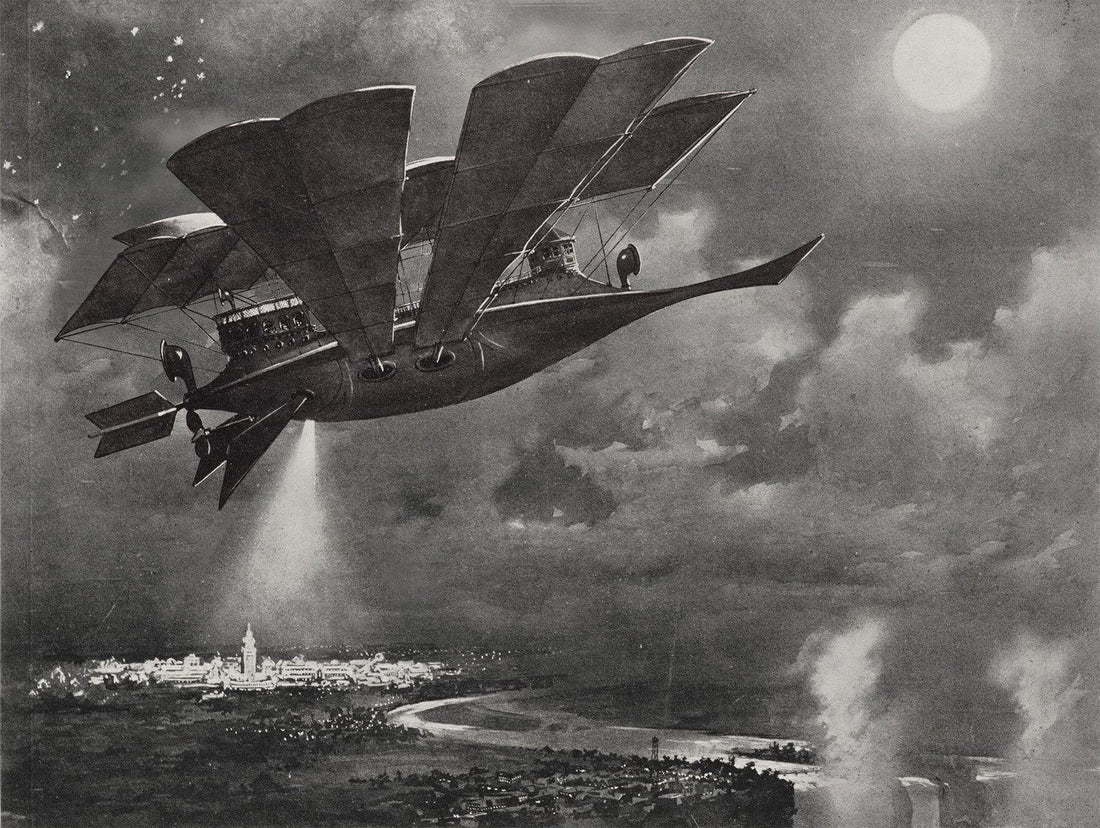A Partnership Destined to Reach the Stars
Frederic Thompson through the late 1800s had been emerging in the amusement industry for his architectural skills combined with a jovial attitude and boyish imagination. He met businessman Skip Dundy in 1898—the perfect business-minded counterpart to Thompson’s larger-than-life ideas.
While enrolled at the Art Student’s League in New York, the 26-year-old Thompson had been looking ahead toward the 1901 Pan-American Exposition in Buffalo, New York. The event, which would celebrate the progress of the 1800s and showcase the upcoming century, was gaining momentum by attracting visitors worldwide to be as prestigious and grand as the Chicago world’s fair held a few years earlier.
Thompson’s crafty business partner, Dundy, collected hundreds of thousands of dollars in construction contracts to fund Thompson’s attraction plans for the 350-acre exposition in Buffalo. This initiative and his drive to develop a new form of entertainment positioned Thompson as the principal architect for the event’s midway.
Watch on YouTube
This article is available in video form with accompanying visuals. Click HERE to watch it.
Determined to Reach New Heights
Combining Thompson’s childlike spirit with an interest in mechanics, experience in architecture, as well as a fascination with illusions and lighting stimulated his motive to conceptualize experiences for the upcoming exposition. He originally drafted an exhibit displaying machinery, but that was declined for not being appealing enough to the average guest. Thompson began thinking bigger.
One day, he saw an airship streaking through the sky and thought to himself hypothetically, “Where will I take the airship?” His boyish, sky-high imagination pushed him to his next idea: “To the moon.”
Inspired by that thought and Jules Verne’s book From the Earth to the Moon, Thompson before night’s end started designing an intricate and elaborate 34,000-square-foot building for the midway—inside, his plans for an adventurous narrative involving an unexplored, exotic world: outer space.
The Exposition and Ride Debut
In May 1901, the Pan-American Exposition opened in Buffalo, New York, dazzling visitors with thousands of glittering lights powered by a generator facility at Niagara Falls nearby. The midway’s brightest star was a first-of-its-kind flight simulator called A Trip to the Moon.
The attraction cost about $85,000, which is nearly $3 million today. Priced at 50 cents per ride, the attraction was the most expensive for visitors to experience at the exposition because of its sci-fi novelty and encompassing storytelling.
The Ride Experience
Inside the attraction, patrons boarded a 30-passenger green and white airship named Luna, which is Spanish for moon. Riders fastened their seat belts and faced outward for the experience. The ship was lined with six canvas wings. The craft was suspended in a large room by guy wires secured from a central pole; this design gave the ship a free-floating sensation similar to a boat dock.
Fitting with the attraction’s narrative, a guide from the Aerial Navigation Company entered and explained that riders were going to an extraordinary adventure made possible by “the great secret of anti-gravitation and aerial flight.”
With the auditorium lights dimmed, the Luna started its journey. A gong rang, and the wings above flapped for liftoff. Guests looked out the sides of the ship to painted panoramas and down below to a painting of the exposition’s grounds; the images and settings changed in various scenes by revolving—a technology known as cyclorama.
The illusion of floating was made real as the ship rocked and swayed with lighting effects projected around the room. A concealed buzzer simulated the sound of an airstream with a wind machine blowing gusts on riders to give the sensation of forward movement. The scenery below receded as if the ship were ascending. The lighting and painting beneath then portrayed the nearby city of Buffalo, now just a sprawling cluster of flickering lights. Riders heard the roar of Niagara Falls while flying over it on their simulated voyage.
As the ship imitated soaring through the atmosphere and into space, riders saw a giant globe representing the world; it faded to a small ball, then shrinking to a speck beneath.
Once surrounded by stars in space, the ship tensely navigated through a cloudy electrical storm with flashes of lightning, and, as it cleared, guests saw their destination in the distance: the moon with a clear face of the Man in the Moon. Its surface had colorful lava-stained rocks and trenches. The ship slowly turned and landed with a thump on the moon’s side into a yawning hole, which was a crater of an extinct volcano.
A Bizarre Post-Show
Visitors then disembarked and explored a papier-mâché recreation of the moon—or at least a creative turn-of-the-century idea of what the moon might look like. The rocky grottos had imprints of faces while costumed, spiked-backed moon characters called selenites roamed the area and gave tours to visitors.
During this portion of the attraction, guests could visit lunar souvenir-filled gift shops, try samples of green cheese, and cross a moat to see the palace of the Man in the Moon. Giants guarded the gates of the royal throne room filled with jewelry and golden props. The fountains and lights added to the regal atmosphere. This room was close to the attraction’s exit—the mouth of a mighty moon-calf that returned visitors from their space odyssey back to the exposition’s midway.
Sky-High Reception
The 20-minute experience received soaring reviews. Visitors were impressed by its thousands of lights and innovation of being the first electrically powered mechanical dark ride in addition to being one of the earliest rides themed to space. About A Trip to the Moon, Billboard magazine called it, “A great success, and could make a great deal more money if it had the capacity.”
Four-hundred-thousand exposition guests rode A Trip to the Moon in the few months it was open before the end of the event in November 1901. A Trip to the Moon provided simulations and illusions that couldn’t be found anywhere else, with some riders being convinced the ship actually moved.
The Ride Relaunches in New Parks
The attraction’s success helped creators Frederic Thompson and Skip Dundy to secure a deal to permanently relocate the ride in Steeplechase Park on New York’s Coney Island. A Trip to the Moon operated in 1902 as an independent concession at its new park.
Behind the scenes, Thompson and Dundy had been having discussions about acquiring the nearby Sea Lion Park with plans to convert the site into Luna Park. Once the duo purchased the property, A Trip to the Moon was disassembled in October 1902 and would find another landing spot in its third location.
A Problematic Relocation Stunt
Thompson and Dundy used the opportunity for a publicity stunt to transport the attraction to its new home. An infamously “bad” circus elephant named Topsy lugged loads of the ride’s timber across a track of greased wood down the street from Steeplechase Park to Luna Park, which was under construction. They also tried to have Topsy drag the Luna airship, but it was too heavy for one elephant to pull.
Topsy, whose abuse has gone well-documented, was being poked in between the eyes with a pitchfork by her trainer, who was aggressively trying to get her to tow heavy construction materials from Thompson’s attraction. Police intervened, leading to the trainer’s arrest, and Topsy was eventually able to haul the Luna airship with the help of a team of horses.
A Trip to the Moon Lands at Luna Park
In 1903, A Trip to the Moon reopened at the brand-new Luna Park—a fitting spot for the Luna airship. The revamped attraction now took riders on a larger 60-passenger ship called the Luna III. The experience was essentially like in years past, but now the Luna III flew above an aerial painting of Coney Island and a bustling Manhattan before ascending into the atmosphere.The Ride's Descent
Skip Dundy, Thompson’s business partner, died suddenly due to heart failure in 1907. Frederic Thompson for the first time in years was now without his collaborator, who had been a tremendous part of his success, particularly his financial growth and stability. Meanwhile, the Jamestown Exposition had been taking place, and The Battle of the Merrimac and the Monitor attraction impressed Thompson. They relocated the attraction to Luna Park in 1908, replacing A Trip to the Moon and using its existing building.
After a seven-year run on three different midways, A Trip to the Moon, which had lost its novelty since opening, officially closed permanently.
After two years, the ride’s replacement was superseded by Thompson’s latest creation: A Trip to Mars by Aeroplane. The new attraction, in the same location as A Trip to the Moon, was similar to the original, including a 30-passenger ship that took riders over Governor's Island, flying through the clouds and stars, and back to earth from their alien journey—all done by visual tricks and narrated by a guide.
Thompson's Legacy Soars On
Thompson, who now had been focusing his time primarily on managing his wife’s Broadway productions, was left with the financial holdings from his late business partner. Unlike Dundy, Thompson was a poor businessman, and, in 1912, he declared bankruptcy despite years of success in the amusement industry.
After suffering from alcoholism and Bright’s disease, Frederic Thompson died in New York City on June 6, 1919, at only 45 years old. His legacy continued to soar in 1924 when Luna Park added a relocated roller coaster and named it Trip to the Moon, thrilling riders with its speed, dips, and turns.
Thompson’s vision and originality would go on to inspire attractions such as Disneyland’s Rocket to the Moon and countless other attractions that transport guests into outer space. His shoot-for-the-stars mentality, clever illusions, cosmically imaginative storytelling, and first-of-their-kind attractions were enjoyed by millions of riders—a vivid escape from planet Earth.





